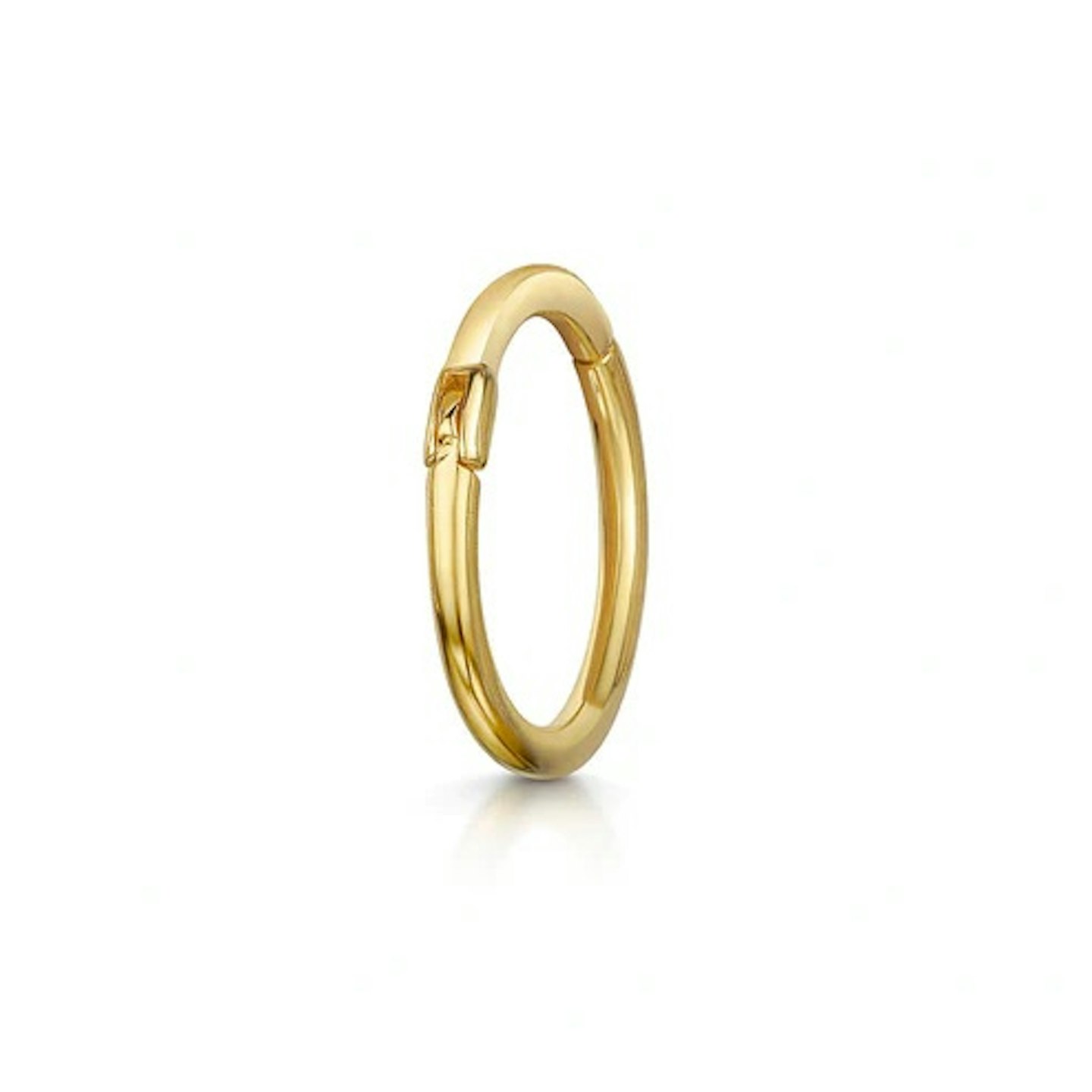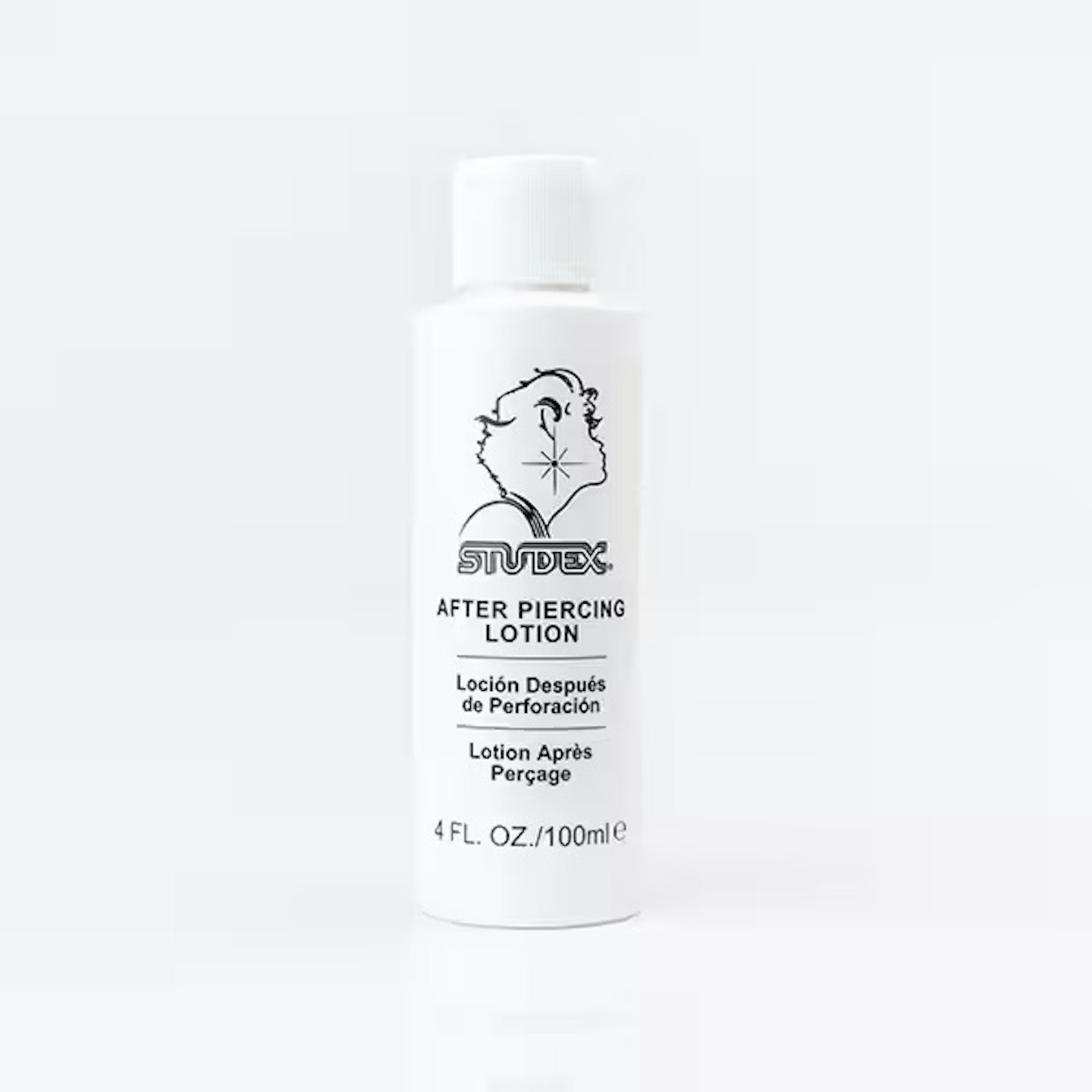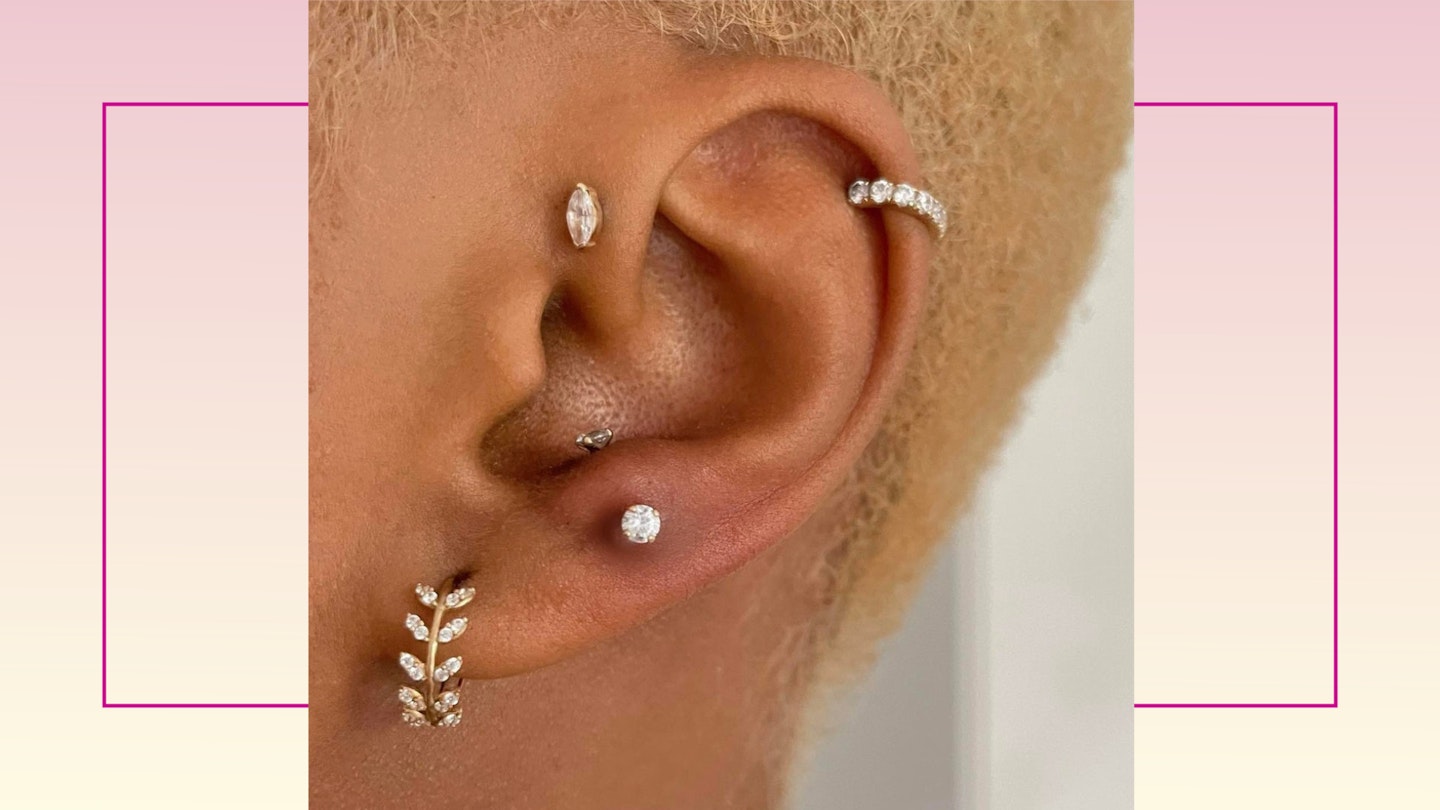Aah ear piercings. There’s no denying it – they’re always in vogue, whether it’s the Florence Pugh-approved septum piercing or the industrial piercing once beloved by the likes of Miley Cyrus. Another piercing in the spotlight? The anti-tragus piercing, a type of cartilage piercing that sit below the tragus. Scroll on for the full 101 guide, brought to you by our experts.
What to expect from our guide
-
What is an anti-tragus piercing?
-
How much does an anti-tragus piercing hurt?
-
How long do anti-tragus piercings take to heal?
-
Costs and aftercare
Meet the experts
-
Sarah Crowe – head piercer at Laura Bond
-
Dr. Chandni Rajani – advanced aesthetic doctor and GP
-
Dr. Raj Arora – NHS GP doctor
What is an anti-tragus piercing?
Considerably more common than a helix piercing, a conch piercing or a classic tragus piercing, the anti-tragus is a type of cartilage piercing that’s placed on a small piece of cartilage opposite the ear canal and makes for an impressive addition to an ear stack. Crowe, says 'The anti-tragus is on the "lip" of cartilage that sits below the tragus and just above the lobe.'
When it comes to determining where exactly it should be pierced, Crowe further explains, 'As with all ear piercings, these are anatomy dependent. You need to make sure there is enough tissue there to support and heal this piercing so it’s always best to have a consultation with your piercer to make sure you are suitable.'
How much does an anti-tragus piercing hurt?
Although far less less painful than a tongue piercing or lip piercing, an anti-tragus piercing does sit a little higher on the pain scale as the skin is tougher than the fleshier lobe. The good news? One deep breath and it's all over.
'The pain of a piercing is all relative and what one person finds painful, someone else won’t,' explains Crowe. 'Things you wouldn’t even think about such as hormonal changes can have an effect on how painful you can find your piercing. Make sure you are in good health, drink plenty of water (which will also help in healing) and make sure you have had something to eat before having a piercing. You can get an adrenaline rush when you’re pierced which can lower your blood sugar levels and can make you feel light headed so having some food ahead of your appointment can help tremendously,' she adds.
That said, Dr Rajani, points out that 'piercing this area involves puncturing through cartilage, which can be more painful and may take longer to heal compared to earlobe piercings. The cartilage structure of the anti-tragus is relatively thin, making it susceptible to potential complications such as infection, keloid formation, and cartilage damage if the piercing is not performed by a professional or if proper aftercare is not followed.'
How long do anti-tragus piercings take to heal?
This one takes a long time to heal (6-12 months and sometimes even longer). Crowe suggests going for the side you don’t sleep on and being very patient. Downsizing your jewellery is important to help you heal, too. Once your swelling has subsided, pop in to see your piercer to have it checked and see if you are ready to downsize. This means your piercer will put a slightly shorter bar in your piercing to allow it to continue healing without it getting caught or snagged. Again, times will vary from person to person but your piercer will probably get you in for a check up around 4-8 weeks after your piercing.
During this healing period, take care with headphones and earbuds as anything that requires entry into the ear cannel may touch the new piercing area and cause irritation or slow down the healing process. In fact, keep all foreign objects, be it hats or hair, away from the area and refrain from touching it. So, as great as they are, don't wear your Apple AirPods until the piercing is fully healed.
Anti-tragus side effects: why does my piercing hurt?
Dr. Arora points out with this type of piercing you will generally see side effects such as swelling, discharge, irritation and discomfort. The pain shouldn’t be any more than any other cartilage piercing but pain may increase considerably and become throbbing in nature if the piercing is infected.
'There is always a risk of infection at the piercing site and this can lead to more systemic illness if not treated quickly and effectively,' she adds. 'Therefore if there are any signs of an infection - see your doctor ASAP as you may need antibiotics. An allergic reaction or infection to the anti-tragus piercing can also cause swelling that may lead to the outer ear being impacted and rarely this can lead to inner ear/ ear canal swelling, which may impact hearing.'
When can I change my anti-tragus piercing?
Piercings heal at different rates, so while your friend might be able to change their jewellery within six earmonths, it may end up being a longer process for you. It’s important to ensure your anti-tragus piercing is fully healed – this means no weeping, crusting or redness. If you suspect an infection, speak to your piercer pronto.
'Your piercer will also be able to help you change your jewellery when it is ready which can be tricky to do on your own when you can’t see round the side of your head,' Crowe adds. 'Make sure your piercing is healed and the jewellery is an appropriate size. Leaving a piercing without jewellery in it can cause it to shrink down and in some cases close up so as always, contact your piercer for assistance.'
Anti-tragus aftercare rules
It is of the upmost importance to keep your piercing clean. During the healing process, Crowe advises cleaning your piercings with a sterile saline solution twice a day for two months, making sure you thoroughly dry them after. 'Moisture in a piercing is one of the main reasons your piercing will fail as is touching with dirty hands, so keep them clean, dry and avoid touching. If you are unsure how your piercing is healing, or if you think your piercing is infected please contact your piercer.'
If you don't have a saline solution to hand, Dr Rajani says a gentle, non-alcoholic, fragrance-free cleanser recommended by a piercing professional will work just fine. 'Avoid using harsh chemicals, alcohol-based products, or hydrogen peroxide, and don't rotate or change the jewellery too frequently initially as these can irritate the piercing, delay healing and disrupt the healing tissue,' she adds.
How much does an anti-tragus piercing cost?
It’s always a good idea to opt for a trusted piercer – which could see you shell out a little more money. But, in our opinion, anything that minimises the risk of infection is worth it. A ballpark figure for an anti-tragus piercing is in and around the £35 mark.
What type of jewellery and jewellery is used for an anti-tragus piercing?
Thanks to its location in the ear and thick cartridge it passes through, this one will swell a lot so it’s very important to get the correct jewellery for this piercing. 'For the anti-tragus, it must be an overly large curved bar, rings are not suitable for the initial piercing due to the amount of swelling. The bars will have either internally threaded attachments or push pins at both ends of the bar.'
'The bar should either be titanium or 14k gold. These contain no nickel which a lot of people have allergies to. They are therefore safe to wear in the body at all times and give you the best chance to heal.'
How to choose the right piercer
Anything beyond a basic ear piecing has the potential to be a pretty big deal. Body modifications should always be done by a professional. That means no at home piercings - it's never a good idea, no matter how tempting it is. 'Choosing your piercer is important in making sure you are pierced in a safe, knowledgeable, sterile environment. Check out piercer’s socials, visit the studio and meet the piercer and word of mouth is always a great way of finding the best piercer for you. Make sure that the studio is health authority registered, too,' adds Crowe.
Shop: The Best Anti-Tragus Piercing

www.laurabond.co.uk
Laura Bond offers up reliable, high-quality jewellery pieces and this is a prime example. While a hoops and rings are not suitable for the initial healing time, this is a great option once the piercing is settled.
Shop: Anti-Tragus After Care

www.superdrug.com
Speed up healing and keep infection at bay with this bargain saline solution.
Main image credit – Instagram: @laura_bond_jewellery

